Mages are the ultimate spellcasters. They use powers of Fire, Ice and the Arcane to conjure powerful spells of any kind. They can concentrate their magic into balls of pure energy to strike their foes, but that’s only the beginning. Mages are great at controlling the huge groups of enemies – they can freeze them all or even drown them in fire.
Being a master of magic gives the class a lot of utility. They can blink, or teleport by a short distance, create a portal to another city, turn invisible on a whim or even transform the foe into a harmless sheep.
Mages focus solely on offense and utility, which means that they have to use their wits as the defense. They are not protected by powerful Armor, nor they can sue their magical powers to heal themselves. Mages know that sometimes it’s better to run from the trouble (after freezing the enemy solid) and that offense often turns out to be the best defense.
In Hearthstone, the Mage class is represented by the Jaina Proudmore. Players can also unlock an alternative, cosmetic Mage Heroes – Medivh and Khadgar.
Want to read about the story behind Jaina Proudmore? Head on over to Wowhead!
Themes and Mechanics
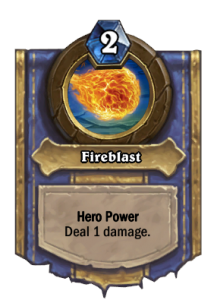 Mage’s Hero Power is Fireblast. It lets the player deal 1 damage to any target including the opponent’s Hero, minions – yours or otherwise – or even your own Hero. While the last two are usually not recommended, there are situations where the ability to do that comes handy. Mage’s Hero Power is the best one for board control. You can remove any smaller minion without sacrificing your own health, or just weaken a bigger minion every turn. It can be used to clear an opposing Divine Shield or even hit your own minion, like Acolyte of Pain, which draws a card every time it’s damaged. Mage’s Hero Power can also be used to deal a small amount of damage to the opponent’s Hero every turn.
Mage’s Hero Power is Fireblast. It lets the player deal 1 damage to any target including the opponent’s Hero, minions – yours or otherwise – or even your own Hero. While the last two are usually not recommended, there are situations where the ability to do that comes handy. Mage’s Hero Power is the best one for board control. You can remove any smaller minion without sacrificing your own health, or just weaken a bigger minion every turn. It can be used to clear an opposing Divine Shield or even hit your own minion, like Acolyte of Pain, which draws a card every time it’s damaged. Mage’s Hero Power can also be used to deal a small amount of damage to the opponent’s Hero every turn.
Secrets are a mechanic that’s unique to Mage. While two other classes also have their own Secrets, they’re all significantly different. Mage’s Secrets are the most expensive, and thus also the most powerful of the three classes (they cost 3 mana each). Or rather, they have the biggest potential, but they’re also the Secrets with the widest range of possible outcomes. Let’s take the most basic Mage Secret – Mirror Entity. It costs 3 mana, but it can get anywhere between 0 and 10 mana of value. If your opponent gives you a copy of a 1/1, it’s like you’ve played a 3 mana Wisp, which isn’t a great deal. However, if you happen to get a copy of the Deathwing, it means that the Secret was well worth it (because you’ve spent 3 mana to get a copy of a 12/12 minion). Other Secrets like Counterspell or Vaporize follow similar rules.
Probably the most iconic and unique Secret is Ice Block, which allows Mage to take lethal damage, yet still survive a turn. It has made a unique Mage play style that’s based around stalling the game and killing the opponent with burn spells possible.
Learn more about Mage in World of Warcraft via Wowhead’s class guides: Arcane Mage Guide, Fire Mage Guide, or the Frost Mage Guide!
On top of the Secrets, Mages also have multiple minions that synergize with them. Combined, they make an archetype that focuses on the Secrets and the mind games viable. There are a lot of different Secret synergies in the Mage class, including: drawing (Arcanologist), playing Secrets for free (Kirin Tor Mage), dealing damage (Medivh's Valet), growing (Ethereal Arcanist) or even reducing mana cost (Kabal Crystal Runner).
There are also some ongoing themes when it comes to the Mage cards. When new cards are released, there is a significant chance that some of them will fall into one of those categories:
- Burn – Mage is the class with access to most burn spells. Burn spells are basically the spells that can deal direct damage to the opponent’s Hero. They are usually used to finish the game after getting the opponent low, but they can often double up as removal. Mage gets some new ways to deal damage pretty much every expansion, but the classic spells like Frostbolt, Fireball and Pyroblast are still very common.
- Freeze – While there are some neutral ways to Freeze (on top of the Shaman’s Frost Shock), it’s the Mage class that really mastered these. They have all kinds of ways to freeze the opponents – AoE (Frost Nova), single target (Frostbolt), spell synergy (Demented Frostcaller), Hero Power (Ice Walker), or even minions that freeze on damage (Water Elemental). Mages also get some cards that synergize with Freezes. So far there are only few – Shatter, Cryomancer and Coldwraith.
- Spell Synergies – Mages are known for their spell synergies. There are many cards that allow them to draw spells or add random spells to their hand, but also cards that activate after playing a spell or making the spells cheaper. Mana Wyrm, Sorcerer's Apprentice, Flamewaker or Archmage Antonidas are some of the examples.
- Big Spells Synergies – Introduced in Kobolds & Catacombs expansion, those spell synergies don’t really fall under the last category. Mage got some unique cards that synergize specifically with “big” (expensive) spells. While the only card that specifies the exact cost is Dragoncaller Alanna (5+ mana), other cards like Raven Familiar, Dragon's Fury and Arcane Artificer have a significantly more consistent and/or powerful effects when you play a deck full of expensive spells.
- AoE Damage – Mages are the masters of board control, including AoE damage. They have multiple ways to strike more than a single foe at once and they get more and more every expansion. While the classic spells like Blizzard or Flamestrike are still powerful, the later additions like Volcanic Potion or Meteor have proven to be as, or even more, useful.
Strengths and Weaknesses
Strengths: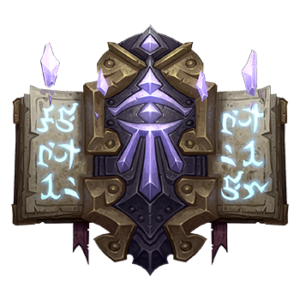
- Burn Damage – A lot of the classes simply can’t finish a low health opponent. They just don’t have a way to do that, especially not through things like Taunts. But Mage isn’t one of those classes. The amount of burn damage this class has is over the top. Every Mage deck plays some cards to close out the games after getting the opponent to low health. Some of the decks are even centered around burn damage and can kill an opponent from 30 without even hitting them with minion once.
- Great Board Clears – When you play against Mage, you should get used to having no minions on your side of the board. Mages have answers for everything – small minions, big minions, swarms of minions. No matter what strategy you take, there is always a Mage spell that can completely disrupt it.
- Defensive/Stall Tools – Even though Mage can’t heal directly, it still has access to multiple defensive tools. The Freeze mechanic is one of them – Freezing a board full of minions is like gaining a lot of health. Ice Barrier gives Mage some sort of protection from minion attacks too, while Ice Block can always stall a game for an extra turn. Combined with a lot of removals, especially AoE ones, it makes Mages really hard to kill.
Weaknesses:
- Reliant on Spells – Mages need spells to do anything. A lot of the minions are useless if you have no spells to back them up. At the same time, if you have a hand full of spells and no minions to play first, it’s also pretty bad. This leads to Mages being more draw-reliant than other classes on the average. For example, if they open with Mana Wyrm and have no cheap spell to back it up, it’s only a vanilla 1/3 minion. Or let’s say if they have Kirin Tor Mage, but not Secret to play alongside, it’s another vanilla minion they have to play.
- Weak Against Healing – No matter what Mage deck you play, your game plan will have something to do with burning your opponent down with spells. And that kind of strategy is usually very weak to healing because generally healing is much more efficient than damage. It makes classes that have access to healing naturally stronger against Mage, and the decks that run some ways to heal are great counters to the Mage decks. For example, a single Forbidden Healing can heal by up to 20, while Mage can do a maximum of 10 with a single spell (Pyroblast). Similarly, minions that heal over time (like Priest of the Feast or Ragnaros, Lightlord) are another great counter to most of the Mage strategies.
- No Healing – While it’s true that the class has access to multiple defensive and stall tools, it has no way to heal itself. Freeze effects or Ice Barrier are great against minion damage, but it can’t block damage from burn spells and Hero Powers. The only tool that can stop those is Ice Block, but it only buys the Mage player a single turn if you’re still within lethal range. That’s one of the reasons why Alexstrasza is so great in this class – it’s used defensively pretty much as often as offensively. More recently, Mages have got a healing card in a form of Arcane Artificer, but given that you have to combo him with an expensive spell right away, he’s more of a late game option.
Meta Decks and Strategies
Here are the Mage decks you can use on the ladder in the current meta. While not every deck listed here is high tier, they all should be viable options, especially to climb through the lower ranks.
Tempo Mage deck has existed for a very long time, with its first iterations using Flamewaker with a bunch of cheap spells to lay devastation on the opponent’s board. It wasn’t focused on the Secrets, but the basic principle was similar – play a bunch of spell synergy minions, spells and then finish your opponent with burn damage.
The current version of Tempo Mage, also called Secret Mage, was born around the beginning of this Standard year. Even though the pieces were released over multiple expansions (Medivh's Valet in Karazhan, Kabal Crystal Runner in Gadgetzan etc.), the final piece to the puzzle – Arcanologist – came with Journey to Un’Goro.
Ever since then, the deck didn’t change that much. Even though it was still viable in Knights of the Frozen Throne, the expansion itself didn’t add that much to the deck (mostly neutral options like Cobalt Scalebane or Bonemare, which were good in every Tempo deck). However, Kobolds & Catacombs cards like Explosive Runes and Aluneth fit perfectly into the list, making the deck much stronger than it was before.
Quest Mage is a deck built around the Journey to Un’Goro’s Mage Quest – Open the Waygate. Quest Mage decks run a lot of ways to generate random spells, as that is the Quest’s requirement. Mage has access to a lot of ways to get spells from outside of the deck, like Babbling Book, Primordial Glyph or Cabalist's Tome.
The most common finisher in a Quest Mage deck a so-called Exodia combo. It gives Mage access to a pretty much infinite damage combo (it’s only limited by the turn timer), but it’s also much harder to accomplish. After finishing the Quest, the Mage needs to play two copies of Sorcerer's Apprentice, then get two more copies with Molten Reflection and finish the Quest. On the next turn, the player drops down Archmage Antonidas and any cheap spell to start the combo. With four copies of Sorcerer’s Apprentice on the board, each Fireball from Antonidas is free and playing it cycles for another Fireball, meaning that you can cast as many as you want, which guarantees a kill outside of some rare situations like Ice Block.
The deck got a bit more consistent in the Knights of the Frozen Throne expansion. With the release of Simulacrum, Exodia Mage can copy one of its Apprentices, which means that cards like Dirty Rat or mill strategies became less consistent counters. While the deck is not very common, it’s definitely a part of the today’s meta.
Kobolds & Catacombs didn’t really add any new cards that Exodia Mage can utilize. While some builds are trying the new Arcane Artificer, the card can improve the late game survivability immensely, but it’s not what the deck needs against fast, aggressive openers.
One of Mage’s strongest aspects is its powerful spell toolkit. Especially high-mana board clears like Flamestrike and Blizzard can swing the state of the game into the Mage’s favor like nothing else.
With Kobolds and Catacombs, Team 5 decided to push a possible Mage control archetype that focusses on using said high-mana cards. This Big Spell Mage shows a lot of potential after its first iterations already while having a unique toolkit at hand to deal with all sorts of meta decks of the new expansion.
On first sight, the deck’s general win condition might not be too clear. Most Big Spell Mage lists are jack-of-all-trades, and that is why every matchup includes a different approach in terms of winning plays.
The general rule of thumb is that this archetype wants not to win, it specifically doesn’t want to lose. What that means is that it tries to deny the opponents’ win condition by keeping the board clear of possible minion threats.
Budget and Basic Decks
If you’re a new player without a big collection, you might be looking for a way to play Mage without spending a lot of your Dust on the Legendaries.
A Basic deck is a deck with only the starter cards. Every player can make it after unlocking the class and leveling it up to 10 (which unlocks every Basic card). It’s a best solution if you have just started playing the game – you can test each class without investing into it.
A Budget deck is a cheap deck with no Epics, Legendaries or Adventure cards. Budget decks only run the basic cards + Commons and Rares, which makes them relatively cheap and accessible even for players who have recently started. Average budget deck will cost up to 2,000 Dust to craft, but the number goes down heavily when you own some of the cards already. Even with a relatively small collection, you should be able to build one with just a few hundreds of Dust.
Basic decks are mostly meant for the Casual mode and up to Rank 20 in Ranked. Budget decks can easily be played up to Rank 10 in Ranked, while some of the better ones can even get you up to Rank 5.
This deck is a basic Midrange Mage. When we’re talking about the full Mage decks, those tend to specialize in one specific thing – it might be Secrets, it might be Burn damage, it might be Freezing minions. But it’s really impossible to build one of them with the Basic cards, so this deck tries to have a bit of everything and squeeze as much value from the Basic cards as possible.
Mage tends to be a great Basic deck choice. It’s the only Basic class with an access to so many powerful removal cards, some of which can double up as a burn. Flamestrike is notoriously known among the new players to be the most broken cards and it might as well be – Basic decks run a lot of minions that are in the range and it might be very hard to play around it. Mage’s Hero Power is also probably the best one among the Basic decks. It’s very easy to understand, it affects the board, it can deal Hero damage if necessary and it can set minions in the range of the removal or make the minion trades better. On the other hand, Mage doesn’t have access to almost any powerful minions, so it mostly has to rely on the Neutral options (with the exception of Water Elemental, which is a great card, but it’s only one card).
Tempo Mage is a very old Hearthstone archetype. First versions of the deck were played back around the GvG expansion, but it really got popular when Blackrock Mountain went out in April 2015, thanks to a powerhouse card – Flamewaker. That 3-drop is long gone from Standard, but it doesn’t mean that Tempo Mage is a bad deck to play. Over the time, Mage has got multiple new tempo tools, which can shine even in a budget deck.
The current Tempo Mage decks are mostly build around Secret cards. While the Secrets themselves are usually a low tempo move, Mage has some tools to cheat them out for free – Kabal Lackey and Kirin Tor Mage. On top of that, the class has a strong 2-drop that draws a Secret (Arcanologist) and a 5/5 minion that gets cheaper and cheaper every time you play a Secret (Kabal Crystal Runner). The deck runs minions with efficient effects (mana discounts, snowballing attack etc.) and a set ot powerful spells to support them.
Tempo/Secret Mage has gained some interesting cards this expansion and is a pretty popular meta deck right now. That said, two of the three new cards included into the lists are Epic (Corridor Creeper) and Legendary (Aluneth), meaning that they sadly can’t get into this build.
So, in the end, the only K&C cards added to the list is Explosive Runes. But maybe I shouldn’t say “only”, as it’s an incredibly powerful Secret, which allows the deck to dominate some of the matchups. Your opponent is forced to either play a small minion and take a lot of damage, or play a bigger minion and get it removed (or at least severely damaged). And since more often than not you’re casting it for free, the tempo gain is massive.
Level-up Rewards
Every 2 levels, up to level 10, you will get two copies of a Basic class card. A lot of those cards are staples, so it’s heavily advised to highly prioritize getting every class to level 10.
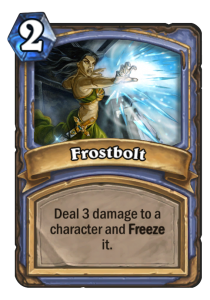 |
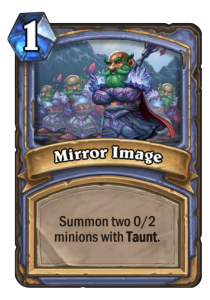 |
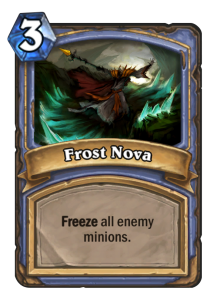 |
| Level 2 | Level 4 | Level 6 |
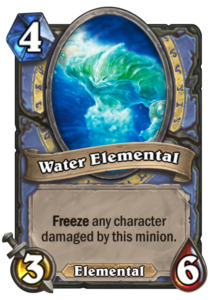 |
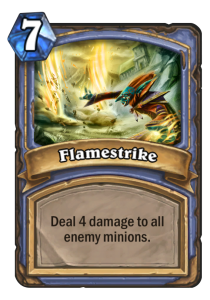 |
| Level 8 | Level 10 |
Every few levels past level 10, you will be rewarded with a Golden version of one of the Basic cards. Leveling up past 10 doesn’t give you any competitive edge – all the rewards are cosmetic.






























































No elemental mage? I’ve been having pretty good succes with it lately.